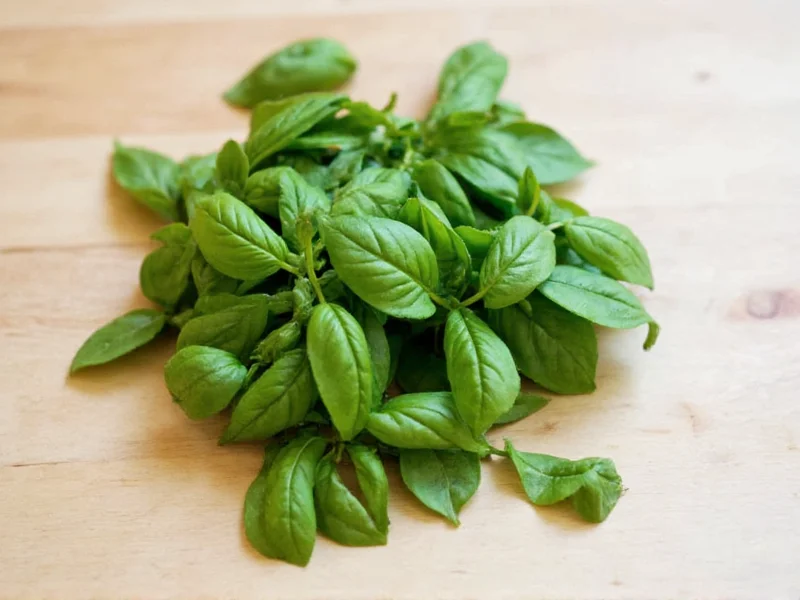The standard conversion ratio for fresh basil to dried basil is 3:1. This means 1/2 cup of fresh basil equals approximately 2 tablespoons (or 1/6 cup) of dried basil. Dried herbs are more concentrated due to moisture removal, requiring less quantity for equivalent flavor.
Understanding Fresh Basil to Dried Basil Conversion
When adapting recipes, knowing how to properly convert fresh basil to dried is essential for achieving balanced flavors. Many home cooks encounter confusion when recipes call for fresh herbs but only dried versions are available. The "1 2" in your query likely refers to "1/2" (one-half), a common measurement in cooking instructions.
Why the 3:1 Conversion Ratio Matters
Fresh basil contains approximately 90% water, while dried basil has most moisture removed. This concentration process intensifies the flavor compounds. The generally accepted culinary standard is:
| Measurement | Fresh Basil | Dried Basil Equivalent |
|---|---|---|
| Volume | 3 tablespoons | 1 tablespoon |
| Volume | 1/4 cup | 1 1/3 tablespoons |
| Volume | 1/2 cup | 2 2/3 tablespoons (or 1/6 cup) |
| Volume | 1 cup | 1/3 cup |
This 3:1 ratio applies specifically to basil and similar leafy herbs. Hardier herbs like rosemary or thyme follow a 4:1 ratio due to their more concentrated essential oils.
Practical Application for Your Recipe
When your recipe calls for 1/2 cup of fresh basil, use 2 tablespoons plus 2 teaspoons of dried basil. For best results:
- Add dried basil earlier in the cooking process to allow rehydration
- Crush dried leaves between your fingers before adding to release essential oils
- Start with slightly less than the conversion suggests, then adjust to taste
- Consider the dish's cooking time—longer cooking requires less dried herb
Factors Affecting Basil Conversion Accuracy
Several variables influence the precise conversion:
Quality of Dried Basil
Freshly dried basil retains more volatile oils than store-bought dried basil that's been sitting on shelves. Older dried herbs lose potency, sometimes requiring up to 50% more than standard conversion.
Recipe Type Considerations
For raw applications like pesto or garnishes, fresh basil is preferable and substitutions work poorly. In cooked dishes like soups, stews, and sauces, dried basil performs well with proper conversion.
Personal Preference Adjustments
Some cooks prefer a 2.5:1 ratio for basil, finding the standard 3:1 conversion too strong. Always taste as you cook and adjust accordingly. Mediterranean cuisines often use more basil than Asian-inspired dishes.
Maximizing Flavor with Dried Basil Substitutions
To get the most from your dried basil substitution:
- Reconstitute dried basil in a small amount of warm water or broth for 10 minutes before adding to recipes
- Combine with a fat source (olive oil, butter) early in cooking to extract flavor compounds
- For tomato-based dishes, add dried basil at the beginning; for delicate sauces, add near the end
- Store dried basil in an airtight container away from light and heat to maintain potency
When Fresh Basil Is Non-Negotiable
Certain applications simply don't translate well with dried basil:
- Caprese salad and other fresh presentations
- Pesto where texture matters
- Garnishes requiring visual appeal
- Cocktails and infused waters
In these cases, consider alternative substitutions like dried oregano (for cooked applications) or simply omit the basil rather than using dried in fresh applications.
Storage Tips for Optimal Herb Quality
Proper storage affects conversion accuracy:
- Fresh basil: Store stems in water at room temperature (refrigeration damages flavor)
- Dried basil: Keep in dark glass containers for up to 1 year (paper bags degrade quality)
- Test dried herb potency by rubbing and smelling—weak aroma indicates reduced strength
Common Conversion Mistakes to Avoid
Many home cooks make these errors when substituting:
- Using equal measurements (1:1 ratio) resulting in overpowering dishes
- Adding dried herbs at the same stage as fresh herbs
- Not accounting for the age of dried herbs
- Measuring dried herbs without packing them lightly
Remember that dried basil won't provide the same bright, grassy notes as fresh—it offers a more concentrated, earthy flavor profile better suited to cooked dishes.
What is the exact conversion for 1/2 cup fresh basil to dried?
1/2 cup of fresh basil equals approximately 2 tablespoons plus 2 teaspoons (or 1/6 cup) of dried basil. This follows the standard 3:1 fresh-to-dried herb conversion ratio used in professional kitchens.
Can I use the same measurement for all herbs when converting fresh to dried?
No, different herbs have varying concentration levels. Leafy herbs like basil, parsley, and cilantro follow a 3:1 ratio, while hardier herbs like rosemary, thyme, and oregano typically use a 4:1 ratio due to their more concentrated essential oils.
Why does dried basil require less quantity than fresh?
Dried basil contains significantly less moisture (about 90% water in fresh basil is removed during drying), concentrating the flavor compounds. This concentration means you need less dried basil to achieve similar flavor intensity as fresh.
How can I tell if my dried basil has lost potency?
Rub a small amount between your fingers and smell it. Fresh, potent dried basil should release a strong, sweet aroma. If the scent is faint or musty, the herb has likely lost significant potency and you may need to use up to 50% more than standard conversion ratios.
Should I adjust the conversion ratio based on cooking time?
Yes, for dishes with long cooking times (30+ minutes), use slightly less dried basil than the standard conversion (try a 3.5:1 ratio) as prolonged heat extracts more flavor. For quick-cooking dishes, use the standard 3:1 ratio or even 2.5:1 for brighter flavor.











 浙公网安备
33010002000092号
浙公网安备
33010002000092号 浙B2-20120091-4
浙B2-20120091-4